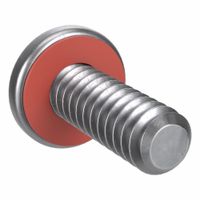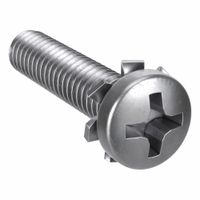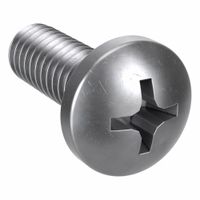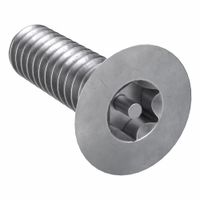Call +(254) 703 030 000 / 751 483 999 / 721 704 777
- Home
- Fasteners
- Bolts Screws
- Machine Screws
.....Read More
Frequently Asked Questions
What are machine screws used for?
Machine screws are versatile fasteners used primarily to hold together components in machinery, electronics, and construction. They are designed to be used with pre-tapped holes or nuts, providing a secure and precise fit. Machine screws are typically smaller in diameter compared to other types of screws, making them ideal for applications requiring precision and strength.
In machinery, they are used to assemble parts such as engines, gearboxes, and other mechanical systems, ensuring that components are tightly secured and aligned. In electronics, machine screws are essential for assembling devices like computers, smartphones, and other gadgets, where they hold circuit boards, casings, and other components together without damaging sensitive parts.
In construction, machine screws are used in metal framing, securing metal panels, and assembling structural components. They are also employed in the assembly of furniture, appliances, and other consumer products, providing a reliable fastening solution that can withstand repeated use and disassembly.
Machine screws come in various materials, including steel, stainless steel, brass, and aluminum, each offering different levels of strength, corrosion resistance, and conductivity. They are available in numerous head styles, such as flat, pan, and round, to suit different applications and aesthetic requirements.
Overall, machine screws are essential components in a wide range of industries, providing reliable and durable fastening solutions for both temporary and permanent assemblies.
How do you choose the right machine screw size?
To choose the right machine screw size, consider the following factors:
1. **Application Requirements**: Determine the specific application and the materials being joined. This will influence the screw's size, length, and material.
2. **Diameter**: Select the screw diameter based on the load it needs to bear. Larger diameters can handle more load. Common diameters range from #0 to #14 for machine screws.
3. **Length**: Measure the thickness of the materials being fastened. The screw should be long enough to pass through the material and engage with the nut or tapped hole, but not so long that it protrudes excessively.
4. **Thread Pitch**: Choose between coarse and fine threads. Coarse threads are better for quick assembly and disassembly, while fine threads provide better holding power and are ideal for thin materials.
5. **Head Type**: Select a head type based on the tool available and the desired finish. Common types include flat, pan, round, and hex heads. Flat heads are flush with the surface, while pan and round heads protrude.
6. **Drive Type**: Choose a drive type that matches your tools, such as Phillips, slotted, or hex. Phillips and slotted are common for general use, while hex drives offer better torque.
7. **Material and Finish**: Consider the environment and required corrosion resistance. Stainless steel, brass, and zinc-plated screws offer varying levels of corrosion resistance.
8. **Standards and Specifications**: Refer to industry standards like ANSI, ISO, or DIN for specific applications to ensure compatibility and performance.
9. **Testing and Prototyping**: If possible, test the screw in a prototype to ensure it meets the mechanical and aesthetic requirements.
By evaluating these factors, you can select the appropriate machine screw size for your specific needs.
What materials are machine screws made from?
Machine screws are manufactured from a variety of materials, each chosen for specific properties that suit different applications. Common materials include:
1. **Steel**: The most prevalent material, offering a balance of strength, durability, and cost-effectiveness. Steel screws are often coated with zinc, black oxide, or other finishes to enhance corrosion resistance.
2. **Stainless Steel**: Known for its excellent corrosion resistance, stainless steel is ideal for environments exposed to moisture or chemicals. It is available in various grades, such as 304 and 316, with 316 offering superior resistance to corrosion.
3. **Brass**: Valued for its corrosion resistance and electrical conductivity, brass is often used in applications requiring low magnetic permeability and aesthetic appeal. It is softer than steel, making it suitable for decorative purposes.
4. **Aluminum**: Lightweight and resistant to corrosion, aluminum screws are used in applications where weight is a critical factor. They are not as strong as steel but are suitable for light-duty applications.
5. **Titanium**: Offering a high strength-to-weight ratio and excellent corrosion resistance, titanium screws are used in aerospace, medical, and marine applications. They are more expensive than other materials.
6. **Nylon and Plastics**: These non-metallic materials are used for applications requiring electrical insulation, resistance to chemicals, or reduced weight. They are not as strong as metal screws but are suitable for light-duty applications.
7. **Alloy Steel**: Known for its high strength and toughness, alloy steel is used in high-stress applications. It is often heat-treated to enhance its mechanical properties.
Each material offers distinct advantages and is selected based on factors such as mechanical strength, environmental conditions, cost, and specific application requirements.
How do you install machine screws?
To install machine screws, follow these steps:
1. **Select the Right Screw**: Choose a machine screw that matches the material and thickness of the components you are joining. Ensure the screw length and thread type are appropriate for the application.
2. **Prepare the Components**: Align the components to be fastened. If necessary, use clamps to hold them in place. Ensure that the holes are clean and free of debris.
3. **Align the Screw**: Insert the machine screw into the pre-drilled or tapped hole. Ensure it is perpendicular to the surface to prevent cross-threading.
4. **Choose the Right Tool**: Use a screwdriver or a power drill with the correct bit that matches the screw head type (e.g., Phillips, flathead, hex).
5. **Start the Screw**: Begin turning the screw by hand to ensure it is threading correctly. This helps prevent cross-threading and ensures proper alignment.
6. **Tighten the Screw**: Use the screwdriver or drill to tighten the screw. Apply steady pressure and turn the tool clockwise. If using a power drill, set it to a low torque setting to avoid over-tightening.
7. **Check Alignment**: As you tighten, periodically check the alignment of the components to ensure they remain properly positioned.
8. **Secure the Screw**: Tighten the screw until it is snug. Avoid over-tightening, which can strip the threads or damage the material.
9. **Inspect the Installation**: Once installed, inspect the screw and the joined components to ensure a secure fit. Make any necessary adjustments.
10. **Finish Up**: If required, apply a thread locker to prevent loosening due to vibration. Clean up any debris or excess material around the installation area.
What is the difference between machine screws and bolts?
Machine screws and bolts are both types of fasteners used to hold objects together, but they have distinct differences in terms of design, application, and usage.
Machine Screws:
1. **Design**: Machine screws are typically smaller in size and have a uniform diameter along their entire length. They are fully threaded from the head to the tip.
2. **Head Types**: They come in various head types, such as flat, round, pan, and countersunk, allowing them to be used in different applications.
3. **Application**: Machine screws are primarily used in applications where precision is required, such as in machinery, electronics, and appliances. They are often used with a pre-tapped hole or a nut.
4. **Usage**: They are designed to be used in tapped holes or with nuts, providing a secure fit. They are ideal for applications requiring a flush finish or where space is limited.
Bolts:
1. **Design**: Bolts are generally larger than machine screws and have a partially threaded shank. The unthreaded portion, known as the grip length, provides additional strength.
2. **Head Types**: Bolts typically have hexagonal heads, allowing them to be tightened with a wrench or socket.
3. **Application**: Bolts are used in construction, automotive, and heavy machinery applications where high strength is required. They are used to fasten materials together by passing through a hole and securing with a nut.
4. **Usage**: Bolts are designed to be used with a nut or in a pre-drilled hole. They are suitable for applications where high tensile strength is needed and where the fastener needs to be removed and reinstalled frequently.
In summary, the primary differences lie in their size, threading, and application, with machine screws being smaller and fully threaded, while bolts are larger with a partially threaded shank and used for heavy-duty applications.
What are tamper-resistant machine screws?
Tamper-resistant machine screws are specialized fasteners designed to prevent unauthorized access or tampering with the equipment or enclosures they secure. These screws feature unique head designs that require specific tools for installation and removal, making it difficult for individuals without the proper tools to manipulate them. Common head types include one-way, pin-in-Torx, pin-in-Hex, and tri-wing, among others. These designs deter tampering by ensuring that standard tools like flathead or Phillips screwdrivers cannot be used to remove them.
Tamper-resistant screws are commonly used in public spaces, electronic devices, and high-security areas where unauthorized access could lead to theft, vandalism, or safety hazards. They are often found in applications such as public restrooms, playground equipment, consumer electronics, and automotive components.
The materials used for tamper-resistant screws are typically durable and corrosion-resistant, such as stainless steel or alloy steel, to ensure longevity and reliability in various environments. Some screws may also feature additional coatings or treatments to enhance their resistance to environmental factors.
In summary, tamper-resistant machine screws are essential components in security applications, providing a simple yet effective means of protecting assets and ensuring safety by preventing unauthorized access or tampering.
How do sealing machine screws work?
Sealing machine screws are designed to create a secure and airtight seal in various applications, such as packaging, industrial machinery, and consumer products. These screws work by combining mechanical fastening with sealing properties to prevent the ingress or egress of fluids, gases, or contaminants.
The primary mechanism by which sealing machine screws operate involves the use of specialized materials and design features. Typically, these screws are equipped with a sealing element, such as an O-ring, gasket, or washer, made from materials like rubber, silicone, or other elastomers. This sealing element is positioned under the screw head or along the threads.
When the screw is tightened, the sealing element is compressed between the screw head and the mating surface or within the threads. This compression creates a barrier that blocks the passage of substances. The effectiveness of the seal depends on the material properties of the sealing element, the precision of the screw and mating surface, and the amount of torque applied during installation.
In some designs, the screw threads themselves may be coated with a sealant or adhesive that cures to form a tight seal once the screw is installed. This is particularly useful in applications where vibration or thermal cycling might otherwise compromise the integrity of the seal.
Sealing machine screws are used in a wide range of industries, including automotive, aerospace, electronics, and food packaging, where maintaining a controlled environment is critical. They are selected based on factors such as the type of material being sealed, environmental conditions, and the mechanical requirements of the application. Proper installation and maintenance are crucial to ensure the longevity and effectiveness of the seal.



